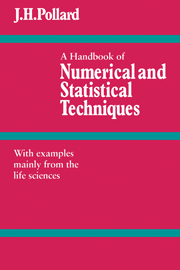Book contents
- Frontmatter
- Contents
- List of statistical and mathematical tables
- Preface
- PART I BASIC NUMERICAL TECHNIQUES
- PART II BASIC STATISTICAL TECHNIQUES
- 8 Probability, statistical distributions and moments
- 9 The normal and related distributions
- 10 The common discrete distributions
- 11 The Pearson system of probability-density functions
- 12 Hypothesis testing
- 13 Point and interval estimation
- 14 Some special statistical techniques
- PART III THE METHOD OF LEAST SQUARES
- Appendix
- References
- Author index
- Subject index
8 - Probability, statistical distributions and moments
Published online by Cambridge University Press: 18 December 2009
- Frontmatter
- Contents
- List of statistical and mathematical tables
- Preface
- PART I BASIC NUMERICAL TECHNIQUES
- PART II BASIC STATISTICAL TECHNIQUES
- 8 Probability, statistical distributions and moments
- 9 The normal and related distributions
- 10 The common discrete distributions
- 11 The Pearson system of probability-density functions
- 12 Hypothesis testing
- 13 Point and interval estimation
- 14 Some special statistical techniques
- PART III THE METHOD OF LEAST SQUARES
- Appendix
- References
- Author index
- Subject index
Summary
Summary In this chapter we summarise the basic results of probability and statistics needed in subsequent chapters. First we outline the axioms and operating rules of probability; we continue with a discussion of univariate statistical distributions, moments, and measures of central tendency, dispersion, skewness and kurtosis. Bivariate distributions and moments are described in the final two sections of the chapter.
The axioms and operating rules of probability
A gambler tosses a coin ten times. This process may be referred to as an experiment. At each toss, the gambler will obtain either a ‘head’ (H) or a ‘tail’ (T). The particular sequence of ‘heads’ and ‘tails’ obtained by the gambler is called the outcome of the experiment, and it is clear that the experiment we have described has 210 = 1024 possible outcomes. The sequence HHTHTTTHHH is one possible outcome.
The gambler may count the number of ‘heads’ he obtains. This number is a random variable which may take any one of the non-negative integer values 0,1,2, …, 10.
Let us imagine that the gambler obtains a sequence containing six ‘heads’ and four ‘tails’. Then, we can say that the event ‘six “heads” and four “tails”’ has occurred, or, for example, the event ‘an even number of “heads”’ has occurred, or the event ‘more “heads” than “tails”’ has occurred.
Each event A has a number P(A) associated with it which is non-negative and less than or equal to one.
- Type
- Chapter
- Information
- A Handbook of Numerical and Statistical TechniquesWith Examples Mainly from the Life Sciences, pp. 75 - 89Publisher: Cambridge University PressPrint publication year: 1977



